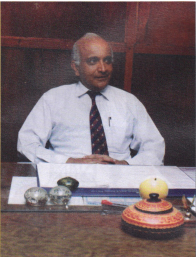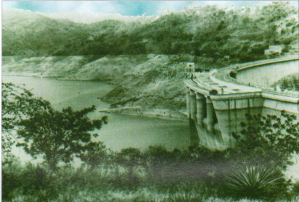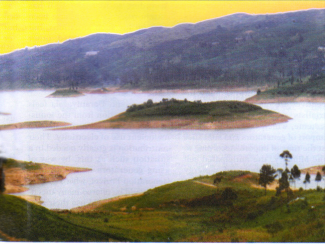In order to avoid a repetition of last year’s power crisis, the Ceylon Electricity Board (CEB) has been set certain terms of reference to make 1997 a year free of power cuts.

“I have been given a clear mandate that we have to get through 1997 without power cuts, either brought through the vagaries of nature or through trade union action”, CEB Chairman, Arjun Deraniyagala told ‘Business Today.’
According to him the CEB has every intention of avoiding what took place last year, both from the point of the power cuts and the total blackout which took place as a result of the employees strike.
In working towards these objectives, the CEB’s principal task has been to anticipate the changing weather conditions. This is attempted through the historical records of weather patterns, using the principles of statistics. “By this, we try to predict what we consider to be the worst case scenario of the weather patterns. However, you can predict statistically to certain levels of reliability”, Deraniyagala said, adding that what could be done is to predict to certain levels of probability, which would be over 90 percent probability. “We feel that the predictions we have made are a reasonable expectation, which is what we call the worst case scenario”, he said.
According to Deraniyagala, there is a gap of about 1500 GW (giga watt) hours in the generation capacity of hydro generation and this gap has to be met by thermal power generation. At the time the crisis arose last year, the country was 85% dependent on hydro power and the thermal power installations which amounted to just 15% and which had a rated capacity of 250 MW (mega watt), were not in proper order. Hence, these installations were unable to generate even the rated capacity, at the time. fall figures for January this year were far worse than last year when there was dry weather, he said. Hence, the projections for January had to be recast and the revived projections revealed a further gap in power generation. In order to meet the January gap, emergency thermal power generation plants are being brought into the country.
The CEB has entered into contracts with foreign specialists, mostly from Europe, to hire thermal capacity. These specialists are those who have generating plants, either small diesel engines or gas turbines. Once these are shipped in, CEB will give them a site to install. “However, there is a limit to what we can substitute, but we are trying to the best of our ability”, said Deraniyagala. Constant reviewing of projections helps the The CEB is constantly review- CEB to meet the gaps with emering their projections and the emergency generation plants. “Basically CEB’s strategy for 1997 is to enhance thermal capacity, first having projected rainfall patterns and then having identified the gaps, to enhance thermal capacity, either through procurement of our own plants or through hiring of emergency plants for a short term basis”, said Deraniyagala.

The 250 MW rated thermal capacity will be enhanced by a further 300 MW. Hence, there will be more than a 100% increase in the rated capacity of thermal power generation. This will take place in the form of various projects during the course of the year, he said.
Firstly, realising that the country was exposed to a power crisis risk in 1997, the CEB in March last year, got the government to fast- track the procurement of a 115 MW gas turbine. This installation at Kelanitissa is capable of generating about 80 million units a month and will come into operation in May this year. “Normally, the procurement of equipment such as this takes several years, but under the emergency situation we were able to procure it for May, this year”, Deraniyagala said.
Further, the procurement of diesel engines which were to be installed with ADB funding and were delayed by about 2 years, will come into operation in Sapugaskanda, this year. Once these are installed another 40 MW will be added to the rated capacity. Early last year, blocks of emergency power were brought into the country on short term lease, by CEB. According to Deraniyagala, at present there is 83 MW of thermal capacity here, which can provide about 275 million units.
The Later in the year, a BOO/BOT project, which is the first such project to get off the ground in Sri Lanka will be installed in Sapugaskanda. The 20 MW plant will have a generation capacity of about 38 million units. “The CEB through its subsidiary, Lanka Transformers, was the principal proponent of the project”, he said, adding that one of the Fortune 500 ASEA Companies, Brown Bovery, will have a 30% stake in this project. Since this project will be commissioned later in the year it will not help to enhance the prevailing capacity, he said. At present, the CEB is refurbishing the gas turbines and the old diesel engines which were not previously generating full power, in order to generate additional thermal power. “At the moment, based on the projections we have for the rain, we feel that this capacity is adequate”, Deraniyagala said. According to the CEB these thermal additions will ensure adequate power supplies not only during the rest of 1997 but also during the dry spell of 1998.

The other projects that are underway include, the setting up of a 40 MW Diesel CEB plant in 1998. In addition, a 17 MW Diesel BOO/BOT plant and a 51 MW Diesel BOO/BOT plant will be installed during the same year. These measures are adequate to meet the demand without any power shortages in 1998, the CEB said. Further, combined cycle plants will come into being in the years 1999 and 2000 with a total capacity of another 300 MW. Kukuleganga, a 70 MW Hydro Power plant is scheduled to be commissioned in the year 2000. Further, a feasibility study for a 300 MW Coal Power plant in Puttalam is underway. This plant is to be connected to the system in the year 2003.
According to Deraniyagala, wind power generation is an option that has been discussed for quite some time, and because the country’s Wind Velocity Regime is marginal, this has not been a very strong option. Wing power studies that have been conducted by the CEB during the past few years show that win speeds are marginal and not enough to make wind power economical.
The CEB has decided to set up with World Bank funding a pilot Wind Power generating project in Hambantota generating a capacity of 3 MW. “This would enable us to study how it works both technically and commercially before proceeding further”, Deraniyagala said. Even though certain private sector institutions have offered to take the risk, the CEB feels that since these wind power generating locations are very remote and the CEB Transmission Grid does not extend to these areas, investment into CEB Grid extension would be very costly. “Wind power is only available for 3 or 4 months a year, the balance of the time those using wind power will expect the CEB to supply power”, he said, adding that it would be costly for the CEB to supply power in such a situation for a few months. This is due to the fact that the cost of the plant has to be set off against the consumption for those few months and this would result in the consumer paying more. “The economic viability of generating wind power has to be looked into”, he said.
In addition, the Upper Kotmale Hydro Power project in Hatton, receiving Japanese assistance will generate a capacity of 150 MW. However, according to Deraniyagala, the Environment Ministry has to give clearance to proceed with the project, because the Environmentalists are protesting that the aesthetics of the waterfalls will be affected. “When looking at the possibility of generating hydro power, we can still generate about 500 or 600 MW and Upper Kotmale is one of the principal sources which we have identified to contribute towards that 600 MW”, he said.

The Uma Oya Hydro Power Project in Badulla will contribute another 150 MW. According to the CEB, the total generation cost of these plants, which include the 115 MW Project, the two 40 MW Diesel extentions, the 3 MW Wind Project, the 150 MW Upper Kotmale Project, the 20 MW BOO/ BOT Project and the 150 MW Uma Oya Project, will amount to Rs. 50,000 million. “These will be considered and studied and based on the availability of funds we will go ahead”, he said, adding that developing the hydro potential in the country to the maximum is vital, because it is an indegenious source of energy and being over dependent on imported oil or coal is not in the interest of the country. “I would like to see the country depending as much as possible on hydro power, which is our own source of energy, but unfortunately the availability of hydro power is limited and the balance is substantial and has to be thermal”, he said.
According to the Ministry of Irrigation, Power and Energy, with the addition of thermal generation plants, the hydro power plants will generate a total of 1400 million units amounting to 57% of the total capacity, while thermal power plants will generate a total of 1050 million units amounting to 43% of the total capacity. In Sri Lanka, unlike in other countries, the demand for electricity at night is much higher than during the day. One of the problems still faced by the CEB is to meet the peak demand at night, when a lot of additional capacity is needed for a few hours. Hence, in order to minimise the inefficient use of electricity, Demand Side Management (DSM) has been set up as a special unit of the CEB. The Unit works on several fronts to minimise inefficient use of electricity and has set up various schemes for consumers.
Among these schemes are the promotion of energy saving lamps. These lamps which have a capacity of 15W, enables the consumer to generate the same intensity of light as a 75W lamp. “Even though these lamps are expensive it is a long term saving”, Deraniyagala said. Having promoted the energy saving lamps among those in the Colombo district, the CEB has proposed to deduct in installments the cost of the lamp from the electricity bill. “We have taken a decision to intensify this campaign through the media”, he said.
According to him another area which should be looked into is the indiscriminate use of air conditioners. “I feel that builders are not conscious of the fact that when they design a building, it should be designed to be efficient when they install air conditioning”, he said. The DSM has decided to set up certain norms to dissuade clients from deciding on such structures, where inefficient use of air conditioning may take place.
Further, DSM has decided to work out a scheme to discourage the import of inefficient air conditioners. The same would apply to inefficient lamps and refrigeration and industrial equipment. In addition, DSM has advised hotels to use solar water heaters due to the high consumption of electricity for water heating

CEB has introduced another scheme called the Self Generation Project, to encourage industrialists to use their own generators. Haying talked to many of the industrialists in Colombo,
Deraniyagala feels that this scheme would bring about a substantial saving on electricity consumption. In addition, many incentives are offered to the industrialists who come under this scheme, which include duty-free import of generators and subsidies at the time of import. According to the Ministry, the anticipated self generated output of energy through this scheme will be about 400 million units per year.
With increasing anticipation among consumers with regard to an additional fuel charge, Deraniyagala feels that the consumers would benefit by this additional charge, by way of having electricity all year long. Further, higher dependence on thermal power generation means that the consumption of diesel fuel will increase, resulting in price increases. “However, before we bring in price increases, it will be looked into very carefully, both from the point of view of the industrialists and domestic consumers”, he said. According to him, the CEB has certain reserves which have been built up for such situations, but when these get exhausted, other possibilities must be looked into. “But, at the moment, this is not being considered and the CEB intends to absorb whatever possible additional charge”, he said.
At present, Deraniyagala feels that participation from the industrial sector is vital in minimising inefficient use of electricity. Their contribution is greatly needed in a situation such as this, by way of using generators under the Self Generation Project, where they in turn would be offered many incentives. “They should use their generators to the maximum, in fact they should start using it right now”, he said.


